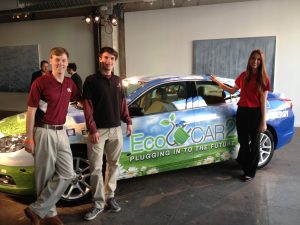
TUSCALOOSA, Ala. — Students from several disciplines across The University of Alabama will compete nationally over the next four years to design an advanced, energy-efficient vehicle, the U.S. Department of Energy and General Motors Co. recently announced.
The University is one of 16 institutions selected for the EcoCAR 3 competition that challenges students to reduce the environmental impact of vehicles without compromising real-world performance or safety.
Students will conceive, design and integrate an innovative, state-of-the-art powertrain into a Chevrolet Camaro, donated by General Motors, with the objectives of maximizing vehicle fuel efficiency, maintaining federal emissions and safety standards, and improving vehicle performance, all while satisfying consumer demands for flawless drivability and affordable cost. The students’ success in meeting these objectives will be evaluated in yearly competitive evaluations before the final evaluation at the end of the contest.
Established by the Energy Department and GM, and managed by Argonne National Laboratory, EcoCAR 3 is the latest Advanced Vehicle Technology Competition, AVTC, aimed at developing the next generation of automotive engineers. The four-year program will conclude in the summer of 2018.
To be successful, universities will need to recruit a team spanning many disciplines such as mechanical, electrical, computer and software engineering, as well as communications, marketing and project management. The multi-disciplinary emphasis imitates a real-world automotive industry environment and gives graduates the skills to enter the field fully prepared for their careers.
The competition introduces students to industry-leading software tools and sophisticated powertrain components and challenges them to face similar engineering design constraints and technical challenges that automakers face, resulting in a real-world training ground for automotive engineering students that is unparalleled in the academic environment.
“The level of support and access to advanced technology this competition offers students is of a whole different caliber than existing engineering student design competitions,” said Dr. Paul Puzinauskas, associate professor of mechanical engineering and a team adviser. “I’m looking forward to seeing what our team will be able to accomplish, and, due to the level of collaboration required to succeed, I hope this challenge will help bring together students from all over the University.”
During the multi-disciplinary competition, engineering students will gain hands-on experience with state-of-the-art equipment through modeling, simulating, designing and testing vehicle components including mechanical, electrical and controls systems. Business students engaging in the competition will receive a crash course in project management, serving roles in risk management, human resources, marketing, fundraising and budgeting and accounting. Opportunities also exist for communications majors in video production, media relations and public relations.
UA students Kaylie Crosby, a junior studying mechanical engineering from Katy, Texas, and Jim Krafcik, a junior in electrical engineering from Saint Louis, Missouri, traveled to Washington D.C. for the announcement of the EcoCAR 3 competition. Both are also starting their first year toward a Master’s in Business Administration as part of the STEM Path to MBA program in UA’s Culverhouse College of Commerce. The program allows high-quality students to combine their studies in science, technology, engineering or math with their interests in business and complete their undergraduate studies and earn a MBA in five years.
“While the competition is a tremendous opportunity for UA’s College of Engineering students to apply what they have learned about engineering, it is also a great opportunity for our STEM Path to the MBA students to see, first hand, the application and importance of the business concepts that they have learned in their STEM Business Honors courses,” said Dr. Rob Morgan, executive director for Innovation Initiatives in Culverhouse. “Few educational opportunities compare to what our students will learn in the EcoCAR3 competition.”
Student participants in this program will have a significant leg up on other students desiring a career in the automotive industry, said Puzinauskas. General Motors has hired more than 100 engineers and managers during its involvement supporting vehicle competitions, and 37 of these individuals have been awarded at least one patent resulting from technology developed on behalf of GM.
“Only a few nationally selected universities have this kind of opportunity where students get hands-on experience on real-world vehicles, and I am proud that the UA is part of it,” said Dr. Hwan-Sik Yoon, assistant professor of mechanical engineering. “The impact of this competition on our education and research programs, especially in automotive engineering, will be tremendous for years to come.”
Dr. Tim Haskew, head of the department of electrical and computer engineering, is also an adviser to the UA EcoCAR 3 team.
For more information on the national competition, including other competing institutions, visit http://www.avtchistory.org.
Contact
Adam Jones, engineering public relations, 205/348-6444, acjones12@eng.ua.edu, or Edith Parten, UA media relations, 205/348-8318, eparten@culverhouse.ua.edu